A pilot to support a just transition from mining to agriculture
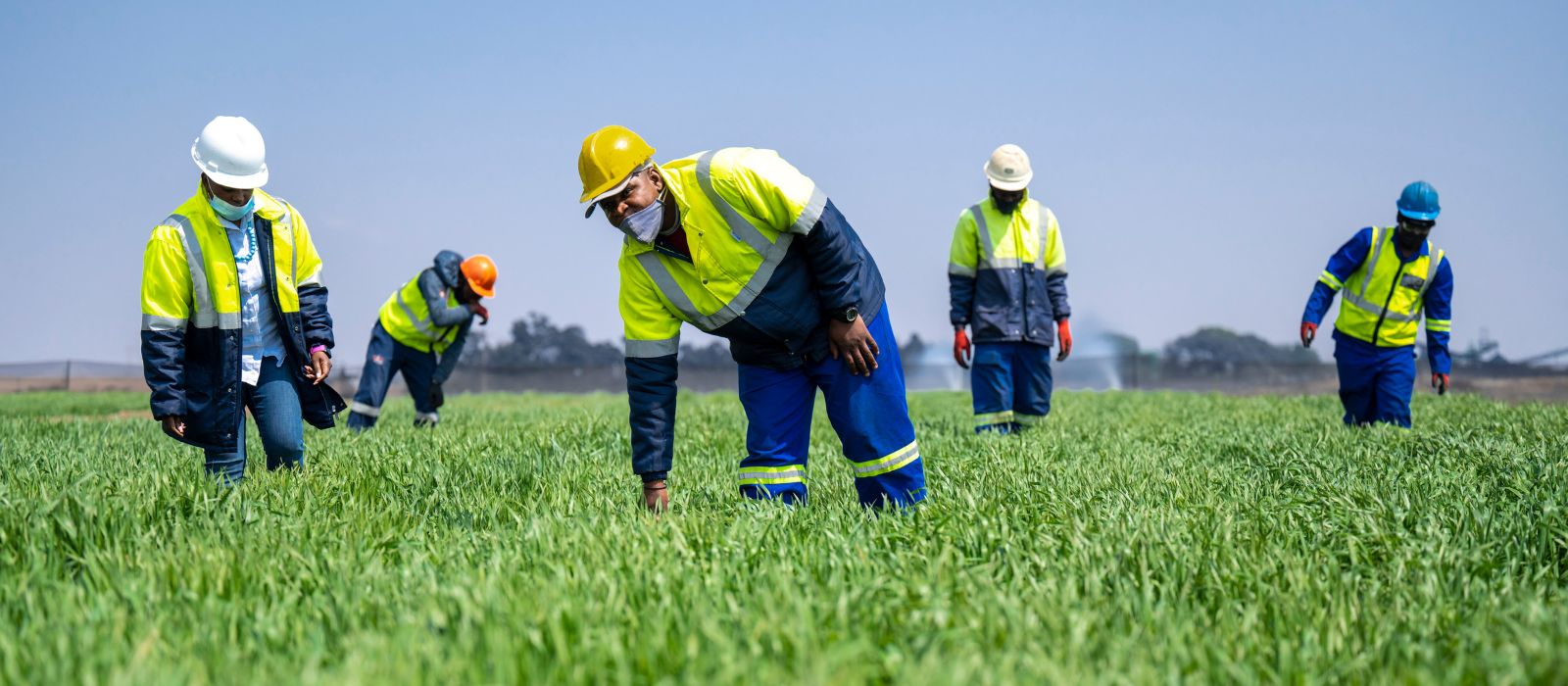
Research and discussion have long been underway regarding the rehabilitation of South Africa's coal mines into other potential economic opportunities.
As the country strives to reduce its reliance on coal for local energy and export revenue, work is required to achieve a just transition where there is ‘an economy-wide process that produces the plans, policies and investments that lead to a future where all jobs are green and decent, emissions are at net zero, poverty is eradicated, and communities are thriving and resilient’ (International Trade Union Confederation, 2017).
This is especially true in Mpumalanga. Eighty per cent of South Africa’s coal is located here, and there is significant dependence on mining as the primary economic driver, either directly as a source of employment or indirectly through local development and services provided.
Historically, mine rehabilitation has primarily focused on the environmental aspects to ensure minimal residual environmental and health impacts post closure. If a just transition is to be achieved, rehabilitation efforts need to broader to mitigate against negative impacts on people, local infrastructure, local services and the community.
To address these impacts and add to the dialogue on potential just transitions solutions, Business for Development with its partners – Glencore Coal, International Council for Mining and Minerals (ICMM), Mine Water Coordinating Body (MWCB) and Impact Catalyst – executed a pilot at Wonderfontein Colliery in Mpumalanga to test the performance of remediated mine land and mine-affected water for agriculture using both modern and smallholder farming techniques.
Methodology
Business for Development designed the pilot to compare the results based on varying inputs. The pilot tested:
- seed varieties: two types of winter wheat
- land type: land had never been mined (unmined land), rehabilitated land and two smallholder farms
- irrigation: mine-affected water, ground water accessed via a borehole and no irrigation where the smallholder farmers relied on rainfed conditions.
Business for Development then compared the results of each approach.
Results
The pilot was successful so far as it proved it is feasible to grow winter wheat at Wonderfontein using mine-affected water and rehabilitated land. Below is an outline of the results, and full results can be found in the report at Business for Development’s website.
Crop yield
Good germination rates were achieved considering how late the pilot was in the planting season. As the data demonstrates (Table 1) the rehabilitated sites irrigated with consistent mine-affected water on average had superior yields to the unmined groundwater irrigated sites.
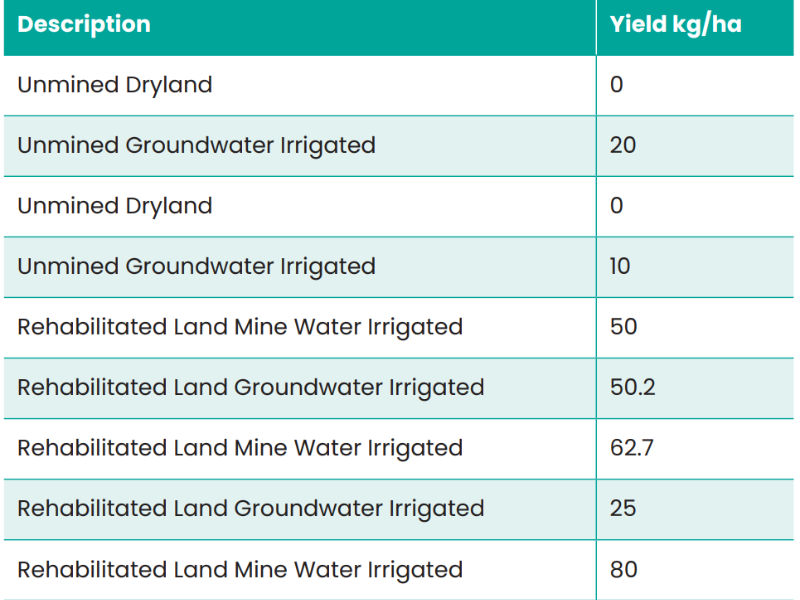
The groundwater sites at rehabilitated and unmined plots were both compromised at critical growth stages due to restricted availability of groundwater (being shared with the mine for daily use). Setting up of three 5000 L water reservoirs helped to achieve uniformity in irrigation scheduling, however it was at a later stage resulting in poorer crop growth.
Interestingly, when sites irrigated with groundwater were compared, the rehabilitated sites (site 6 and 8) performed better than the unmined (site 2 and 4).
As expected, performance of irrigated winter wheat (regardless of the water type) exceeded non-irrigated sites (residual ground moisture only). Due to moisture stress experienced by the dryland crops, they quickly matured and attracted birds in the process resulting in substantial grain losses spreading to the irrigated sites.
The overall grain yield obtained was low for commercial significance and below the average South African winter wheat yield per hectare. The production potential of Wonderfontein’s winter wheat could be significantly improved towards commercial levels if the optimum pH for growing wheat is attained through proper soil conditioning (eg liming, basal and topdressing fertiliser), planting within the planting window and ensuring proper fertiliser management through the growth cycle.
Grain quality
The wheat grain grown using mine-affected water in Wonderfontein was tested by Agreenco and the Agricultural Research Council (ARC) – Institute for Soil, Climate and Water for heavy metal levels of concern. They were found to be all lower than the recommended international and South African safety thresholds. The plant available cadmium and lead ranged between 0.01 to 0.02 mg/kg and 0.02 to 0.04 mg/kg respectively, levels that are far below the maximum recommended soil screening values and too insignificant to pose environmental or health risks. No plant available mercury and arsenic were detected in the sample soils and the grain.
Test results from Agreenco show the following heavy metals in grains.
Zinc (Figure 1) was slightly above tolerance levels for rehabilitated mine land using mine-affected water, however, it is worth noting that this mineral is commonly deficient in African diets (Harika, Faber and Samuel, 2017). When selecting future seeds for piloting it would be interesting to test zinc fortified seeds versus non-fortified to measure the impact.
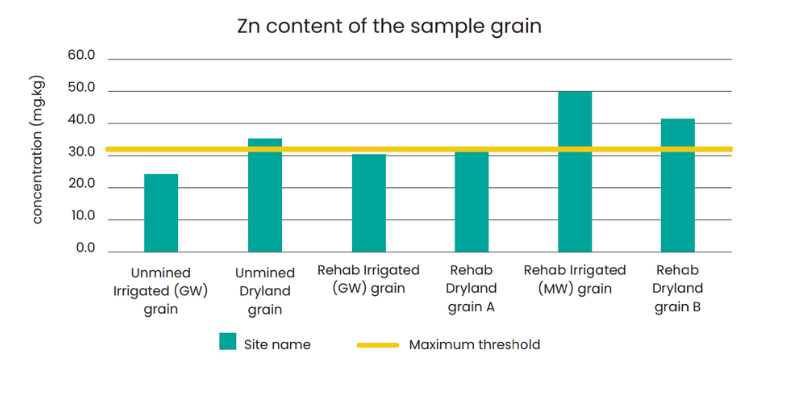
Iron (Figure 2), like zinc, is a desired micronutrient in African diets to address malnutrition. The highest concentration of iron in the grain was found in unmined dryland sites.
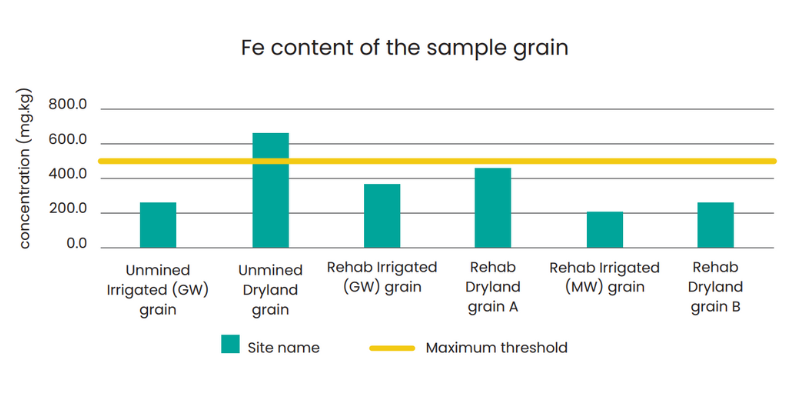
Aluminium (Figure 3) was near or above threshold at all the unmined sites and dryland rehabilitated sites. The total and plant available aluminium in the soils and in the water sources were below threshold values. Further testing is required to understand the root causes.
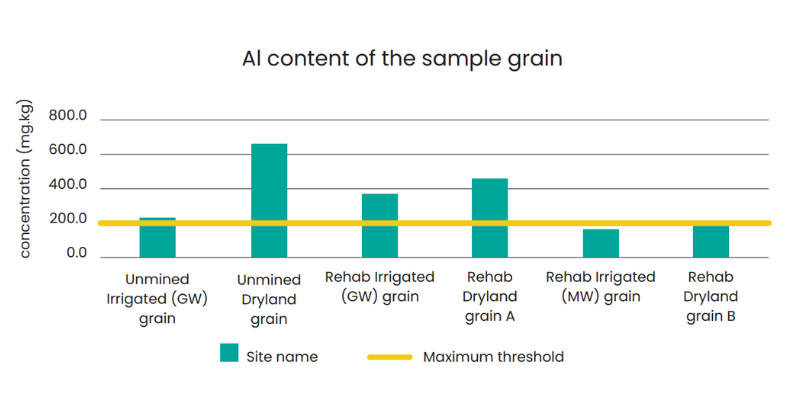
Deriving essential micronutrients such as iron and zinc from crop residue irrigated with mine-affected water presents a potential opportunity to address micronutrient deficiencies in South Africa. If managed properly, the commercial value of micronutrient richer crops could potentially be marginally higher.
Soil pH
At the start of the production season, the soil pH for both rehabilitated and unmined sites were acidic. With the mine-affected water being alkaline, the soil pH at the rehabilitated site increased by 1.05 pH (Figure 4). The unmined sites used groundwater with a nominal 0.05 pH increase. Recommend future tests should include site specific water quality data (improving comparative results).
Soil acidity is a significant issue in South Africa, with both commercial and smallholder farmers relying heavily on using lime to address acidity. The hefty financial burden of liming can potentially be reduced by using mine-affected water.
Groundwater is generally assumed to be of higher quality than mine-affected water, however, pilot results indicate the groundwater did not yield better results than the mine-affected water, nor contribute to improved soil pH.
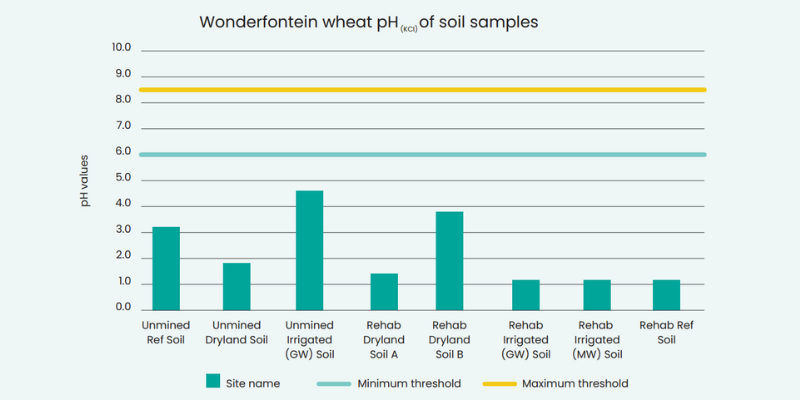
Electrical conductivity (EC)
The rehabilitated sites irrigated with mine-affected-water had a three-fold increase in soil salinity when compared to the initial representative soil samples (Figure 5). This was near the maximum threshold level for crop production, indicating risks of using this water source over the long-term without intervention. While wheat is tolerant to soil salinity, most crops are not. Proper soil conditioning helps to improve the EC. The EC of mine-affected water is expected to have a negative impact especially on saline soils with low buffer capacity. Although irrigation with saline water is possible, rigorous water management and monitoring will need to be done. Growing crops continuously using mine-affected water may salinize the soil and limit its future capabilities for crops and pasture production.
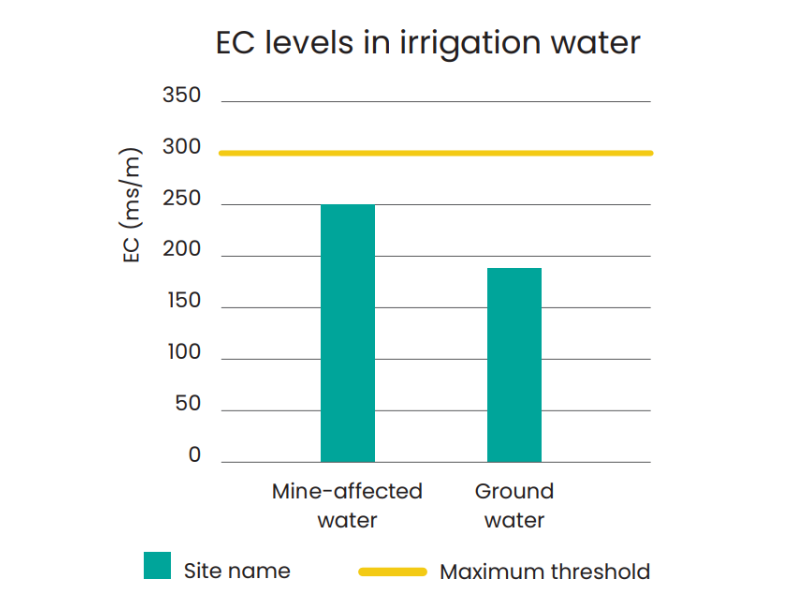
Irrigation water quality
The quality of the groundwater from the borehole and the mine-affected water used for irrigation was assessed by Agreenco. The water quality is of acceptable levels except for the sulphate concentration, which was almost three times more than the recommended value for human consumption from the mine-affected water source and nearly double the recommended value from the groundwater (Figure 6). However, when assessing the grains, the sulphate ranged from 0.12 to 0.15 percent, which is at an acceptable minimum threshold (Figure 7).
Nitrate concentrations in both irrigation water sources were below the minimum threshold. Having reasonable nitrate concentrations in the irrigation water can help to supplement the nitrogen requirement of crops. Nitrates should be added when topdressing with a nitrogen rich fertiliser, noting this did not occur in the pilot due to unforeseen circumstances.
Geochemical assays and modelling the impacts of expected changes in both groundwater and mine-affected water qualities over time is essential, as the chemistry does evolve.
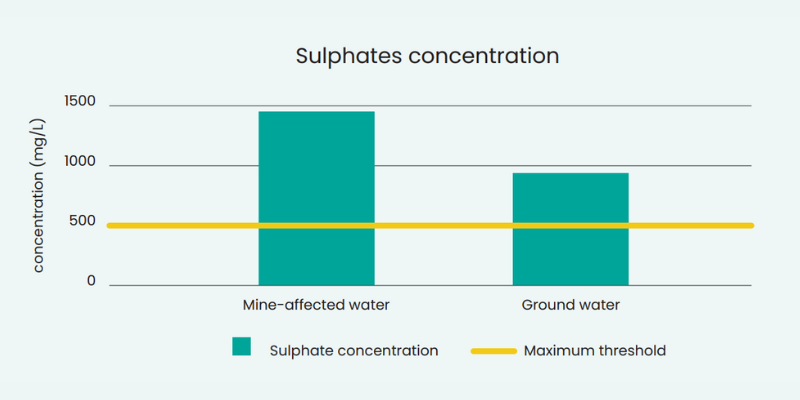
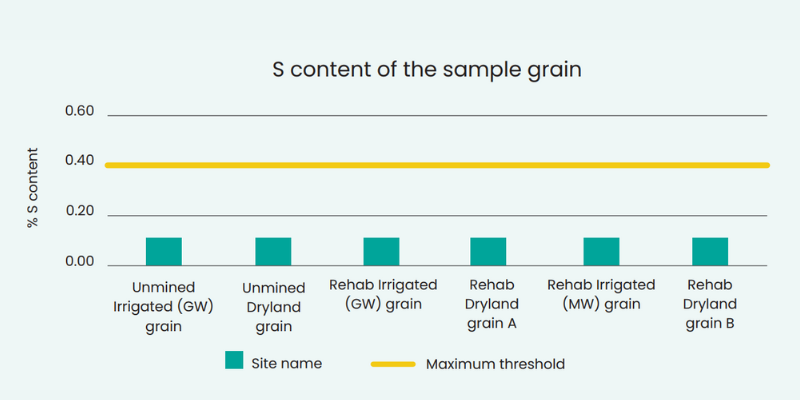
Post-harvest soil fertility and risk factors
The macronutrients (phosphorus, calcium and magnesium) in the soils were not eroded by the pilot. Organic carbon, a key sustainability indicator for rehabilitated soils, was reasonably good especially at the rehabilitated sites.
Residual nitrates in both rehabilitated and unmind land were extremely low as the plants utilised all the nitrogen in the soil. Effectively treating mine-affected water and rigorously following a nitrogen fertilisation
Conclusion
If we continue to view rehabilitated mine land and mine-affected water as degraded to a point where it is completely redundant in countries where smallholder agriculture is part of the fabric of the society and economy, then we will continue to have lost sight of the potential to provide communities the resources (land and water) and knowledge they need to achieve sustainable development through agriculture post-mine closure.
The winter wheat pilot at the Wonderfontein site proved rehabilitated mine land and mine-affected water are valuable assets that can offer tangible benefits to local communities, however more work is required to mitigate against some of the negative soil impacts of using mine-affected water. Such use for agricultural purposes, if correctly applied, could offer much needed local economic growth in Mpumalanga.
With mine closure imminent in many areas of Mpumalanga, smallholder farmers must be equipped with relevant updated climate smart agriculture training and agronomy technologies to enable an effective transition from mining into viable and profitable farming enterprises. If properly managed, “Mpumalanga offers numerous opportunities for investors, agricultural and green technology manufacturers, service providers, distributors, and others in the value chain to support and enable the transition to a more sustainable agriculture sector” (Mpumalanga Green Cluster Agency, 2021).
Although this pilot does demonstrate opportunities, further detailed assessment of other mine sites is required to ascertain whether results can be replicated and to estimate the level of investment needed to rehabilitate mine land and to utilise mine-affected water so agricultural post-mine economies can be implemented. Furthermore, such transition strategies will consider how the long-term environmental impacts of coal mining can be mitigated. The impact of climate change and its potential influence on the future economic viability of the agriculture sector must be addressed. Reuse of post-mine assets may also support alternative employment and livelihoods for local communities.
If we are truly going to be sustainable, we need to challenge conventional wisdom, test assumptions, bridge sectors, partner and embrace change to take measured risks. Agile and focused pilots like this with partners – including mining companies, government, key businesses and communities – can support the development of a positive legacy and generate a “Just Transition” for todays and future generations.
South Africa is implementing a Nationally Determined Contribution strategy to reduce the country’s carbon dioxide emissions and wean off the dependence on coal as a source of energy. This will have significant implications for the Mpumalanga economy which is heavily reliant upon coal production. Strategic transition of decommissioned mine sites and the use of mine-affected water for agricultural purposes has been shown through this pilot to offer significant potential for the betterment of local communities which will no doubt be impacted economically by such mine closures. The door is open for this key province of South Africa to establish a sustainable strategy mine site refurbishment to the benefit of both its economy as well as its local communities.
References
Harika R, Faber M and Samuel F, 2017. ‘Are Low Intakes and Deficiencies in Iron, Vitamin A, Zinc, and Iodine of Public Health Concern in Ethiopian, Kenyan, Nigerian, and South African Children and Adolescents?’ National Library of Medicine [online]. Available from: https://journals.sagepub.com/doi/full/10.1177/0379572117715818
International Trade Union Confederation, 2017. ‘Just Transition – Where Are We Now and What's Next? A Guide to National Policies and International Climate Governance’ [online]. Available from: www.ituc-csi.org/just-transition-where-are-we-now
Mpumalanga Green Cluster Agency,2021. ‘Mpumalanga Sustainable Agriculture Market Intelligence Opportunity Brief 2021’ [online]. Available from: https://www.green-cape.co.za/assets/Uploads/04-10-2021/MPUMALANGA_2021-AGRI_MIR_FINAL_DIGITAL.pdf